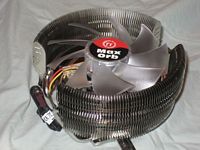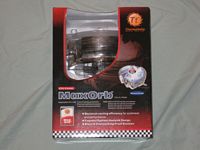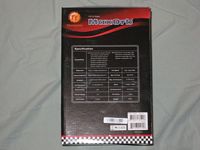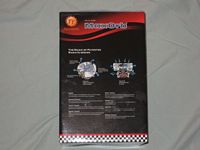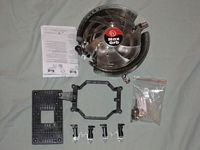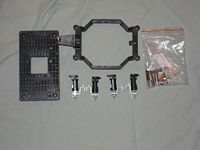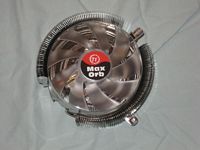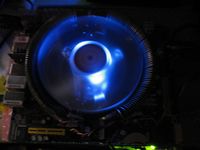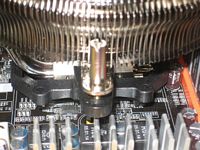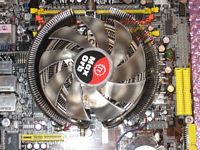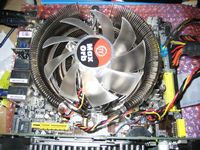In keeping with the bigger is better philosophy for processor cooling, Thermaltake has released the MaxOrb CPU Cooler. Does the size of the heatsink and number of fins mean better cooling or is this just another fad in the pc building world? I recently reviewed the massive Scythe Infinity, now Thermaltake is weighing in (pun intended) with their heavyweight CPU cooler, the MaxOrb.
Thermaltake MaxOrb CPU Cooler
Reviewed by: Tomas Ratas
Edited by: Kristofer Brozio
Sponsor: Thermaltake
Apparently the term Max is taken literally by the folks at Thermaltake. Did I mention that the MaxOrb is huge! Now bigger does not always mean better, so lets see if the MaxOrb CPU cooler is the next heavyweight contender or pretender.
Lets get started..
Tech Specs,Features or the Basic Info:
Thermaltake MaxOrb
Enthusiast Cool with Style~
Specifications:
Compatibility: Socket LGA 755, Socket AM2, Socket 939, Socket 754
Dimension: 143 (L) x 114 (D) x 95.2 (H) mm
Heatsink Material: Copper Base & Aluminum Fin
Heatpipe: Copper Tube 6mm x 6pcs
Fan Dimension: 110mm x 25mm
Rated Current: 12v
Started Voltage: 7v
{amazon id=’B000PYH59A’ align=’right’}
Power Input: 3.00W
Fan Speed: 1300 ~ 2000 RPM
Max. Air Flow: 86.5 CFM
Max. Air Pressure: 2.22mmH2O
Noise: 16dBA ~ 24dBA
Life Expectation: 50,000 hrs
Connector: 3 Pin
Weight: 465g
Construction: Copper Heatpipe and Base / Aluminum fins
Onboard rheostat
Product Link:
http://www.thermaltakeusa.com/product/Cooler/Retail/Cl-P0369/cl-p0369.asp
{mospagebreak title=A Better Look at things}
A Better Look at Things
:
The Thermaltake MaxOrb CPU Cooler arrives in a large box with a plastic window showing one edge of the MaxOrb.
The front of the red and black colored box features a couple of images of the CPU cooler and the processor types it fits. On the back there is a text box featuring the coolers specifications.
The side panels, on one side, feature an explanation of the aerodynamics of the device and on the other offer some close up pictures and details of the MaxOrb.
Upon opening the box, there is a large plastic clamshell which houses the CPU cooler. At the base of the clamshell, a white box containing all the accessories is found.
This box contains a retention frame, an AM2 back plate, four LGA 755 mounts, thermal paste, instructions, a locking nut, four screws and standoffs.
A Better Look at Things
Continued:
The aluminum fins surround most of the circumference of the cooler. At its widest diameter, the top of the MaxOrb is 5 inches across. At its highest it is slightly less than 4 inches. It weighs in at 465 grams, which is about half the weight of the Scythe Infinity.
At the center of the MaxOrb is a 110 mm fan with the red and black Thermaltake logo and the MaxOrb name in white.
When powered on the MaxOrb yields a pleasant blue glow from the LED fan. The fan is not covered by any type of grill, so care must be taken when the MaxOrb is powered.
The aluminum fins are fairly thin and can be easily bent. The base, which is composed of copper is pre-lapped and has a nice mirror like finish.
Coming off the base are six copper heat pipes which allows an even dispersal of heat over the aluminum fins.
Opposite to the heat pipes, is a rheostat which allows adjustment of fan speed. The rheostat has two fan speeds low (1300 rpm) and high (2000 rpm). The draw back is that since it is located on the MaxOrb, you will need to open the case and reach in to make any such adjustments.
Installation, Testing and Comparison
For installation I used the following system:
CPU: AMD Opteron 165
Motherboard: DFI Lanparty NF4 Ultra (Bios – 704-2BTA) Socket 939
Ram: 1 GB of Corsair Value Select
Storage: 200GB Maxtor 7200 PATA
Video card: eVGA 7600GT
PSU: OCZ Powerstream 520 Watt SLI
The included back plate is for AM2 systems, so the stock backplate on the Socket 939 can be used with the MaxOrb. The stock retention frame must be removed and replaced with the Tt universal retention plate. The new retention frame is secured with the four included stand off screws.
Installation of the MaxOrb heatsink involves applying a thin layer of thermal grease to the cpu, then placing the MaxOrb onto the CPU and hooking the clip to the retention frame. Then using LARGE amounts of pressure, secure the MaxOrb to the retention frame with the locking nut.
Now I am a fairly big person and it took a lot of pressure on my part to secure the MaxOrb. I was actually worried that I was going to crush my CPU through the HIS (integrated heat spreader). Another thing I noticed is that the universal retention plate seemed to have lots of laxity prior to the HSF attachment. However that was quickly remedied once the MaxOrb was locked into place.
One immediate drawback to the Thermaltake MaxOrb was that I was unable to use my 2 GB of Corsair TWINX2048-3500LLPRO because the heatspreaders were too high, making it impossible to install them with the MaxOrb in place.
For testing I ran the PC at stock (200 x 9) and at an overclock of (280 x 9) for a speed of 2520. The pc ran at idle for a half hour and was stressed for a half hour using Orthos (http://sp2004.fre3.com/beta/beta2.htm) and running the F.E.A.R timed demo.
Cooler | Idle | Load |
Stock AMD | 34 | 43 |
Stock AMD w/ OC | 38 | 53 |
MaxOrb – Low | 33 | 39 |
MaxOrb – Low w/ OC | 38 | 51 |
MaxOrb – High | 31 | 37 |
MaxOrb – High w/OC | 35 | 42 |
As you can see from the table and graph, the MaxOrb provides excellent cooling even with a moderate overclock of 2.5 on an Opteron 165. The MaxOrb provides better cooling with the faster fan speed, causing a sacrifice in sound for better cooling temperatures.
Summary:
The Thermaltake MaxOrb is an excellent cooling option for both the modder and overclocker. For the modder, it adds a unique looking cooler with a subtle yet distinctly noticeable blue light. The overclocker will see improved temperature readings over the stock AMD cooler when using a socket 939 motherboard.
Performance wise, the Thermaltake MaxOrb does not disappoint. The only drawbacks involve the difficulty in installation and the rheostat control being located on the cooler itself. These are rather small inconveniences and do not stop me from recommending the MaxOrb CPU cooler.
DragonSteelMods gives the MaxOrb CPU Cooler a 4.5 out of 5 score.

{mosgoogle right}
Pros:
-Excellent Cooling performance
-Quiet operation at lowest fan speeds
-Nice Blue LED Fan
-Built in Rheostat
Cons:
-Needs lots of force to install
-Rheostat is on the cooler itself
I would like to thank Thermaltake for the chance to review the MaxOrb CPU Cooler and for their continued support of DSM.

